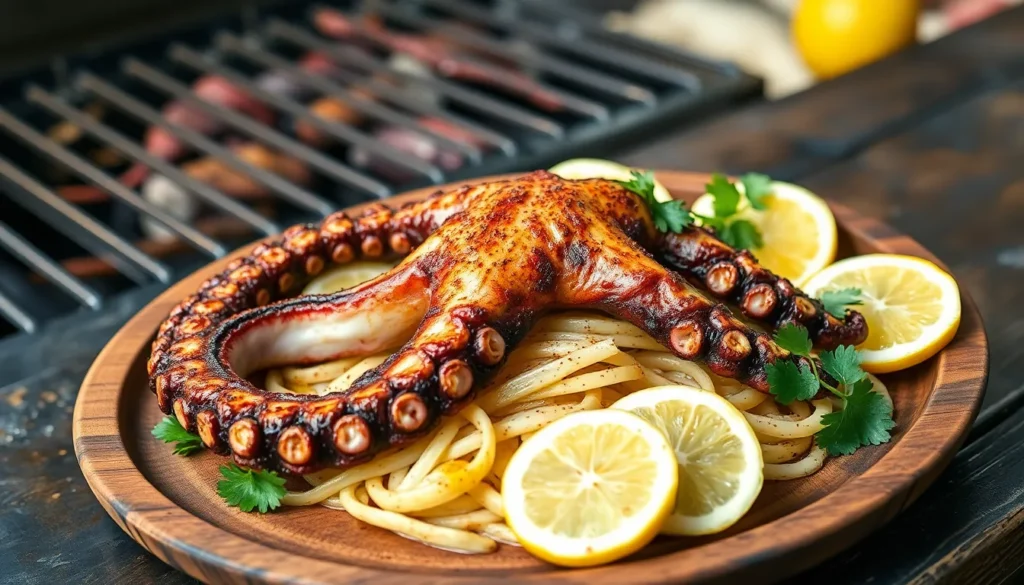Grilled octopus transforms from a seemingly intimidating ingredient into Spain’s most beloved coastal delicacy with the right technique. We’ve perfected this traditional Spanish recipe that delivers tender, smoky octopus with that coveted charred exterior that makes your taste buds sing.
Spanish coastal towns have been grilling octopus for centuries, and there’s a reason this dish remains a staple on tapas menus worldwide. The secret lies in proper preparation and understanding how to achieve that perfect balance between tender flesh and caramelized edges.
We’ll show you exactly how to tenderize the octopus beforehand and master the grilling technique that Spanish chefs have used for generations. This isn’t just another seafood recipe – it’s your gateway to creating restaurant-quality pulpo a la plancha that’ll have everyone asking for your secret. Let’s jump into this authentic Spanish grilling method that turns octopus into pure culinary gold.
Ingredients
Our Spanish grilled octopus recipe requires carefully selected ingredients that work together to create the perfect balance of Mediterranean flavors. These components will help us achieve that coveted tender texture and smoky char that makes this dish irresistible.
For the Octopus
- 2 to 3 pounds fresh octopus (cleaned and tentacles separated)
- 1 bay leaf
- 1 lemon (halved)
- 2 tablespoons coarse sea salt
- 8 cups water
For the Marinade
- 1/4 cup extra virgin olive oil
- 3 cloves garlic (minced)
- 2 tablespoons fresh lemon juice
- 1 tablespoon smoked paprika (pimentón dulce)
- 1 teaspoon sweet paprika
- 1/2 teaspoon red pepper flakes
- 1 teaspoon kosher salt
- 1/2 teaspoon freshly ground black pepper
- 2 tablespoons fresh parsley (chopped)
For Serving
- 2 large potatoes (boiled and sliced)
- Extra virgin olive oil for drizzling
- Flaky sea salt
- Fresh lemon wedges
- Additional smoked paprika for dusting
- Fresh parsley sprigs for garnish
Equipment Needed
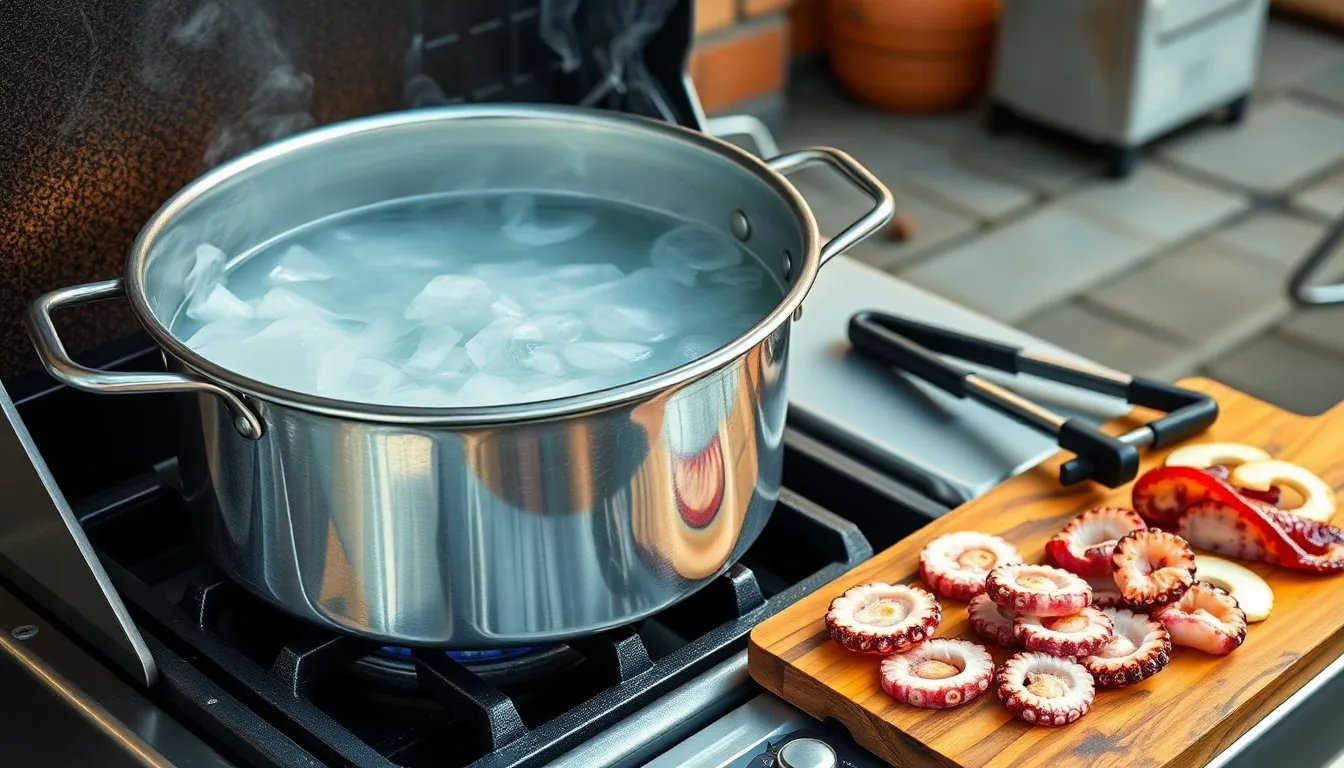
Having the right equipment makes all the difference when preparing authentic Spanish grilled octopus. We need exact tools to handle both the initial tenderizing process and the final grilling stage that creates those signature charred edges.
A large pot serves as our foundation for the boiling process. This vessel needs sufficient capacity to accommodate 2 to 3 pounds of octopus while allowing room for the water to circulate freely during the 40 to 60 minute cooking time.
Our gas or charcoal grill provides the high heat necessary for achieving the perfect char. Medium-high heat settings work best for creating those crispy edges while maintaining the tender interior we achieved through boiling.
Grill tongs become essential for safely maneuvering the octopus tentacles during the grilling process. These tools prevent overcooking by allowing us to flip the pieces quickly and efficiently without piercing the delicate flesh.
A large bowl accommodates the marinating stage where our octopus absorbs the olive oil and garlic flavors. This container needs enough space for the octopus to rest comfortably while developing those Mediterranean tastes.
Finally, we rely on a cutting board and sharp knife for precise slicing of the tentacles before grilling. Clean cuts ensure even cooking and professional presentation when we serve our pulpo a la plancha.
Each piece of equipment plays a crucial role in transforming our octopus from tough seafood into the tender Spanish delicacy that coastal towns have perfected over generations.
Instructions
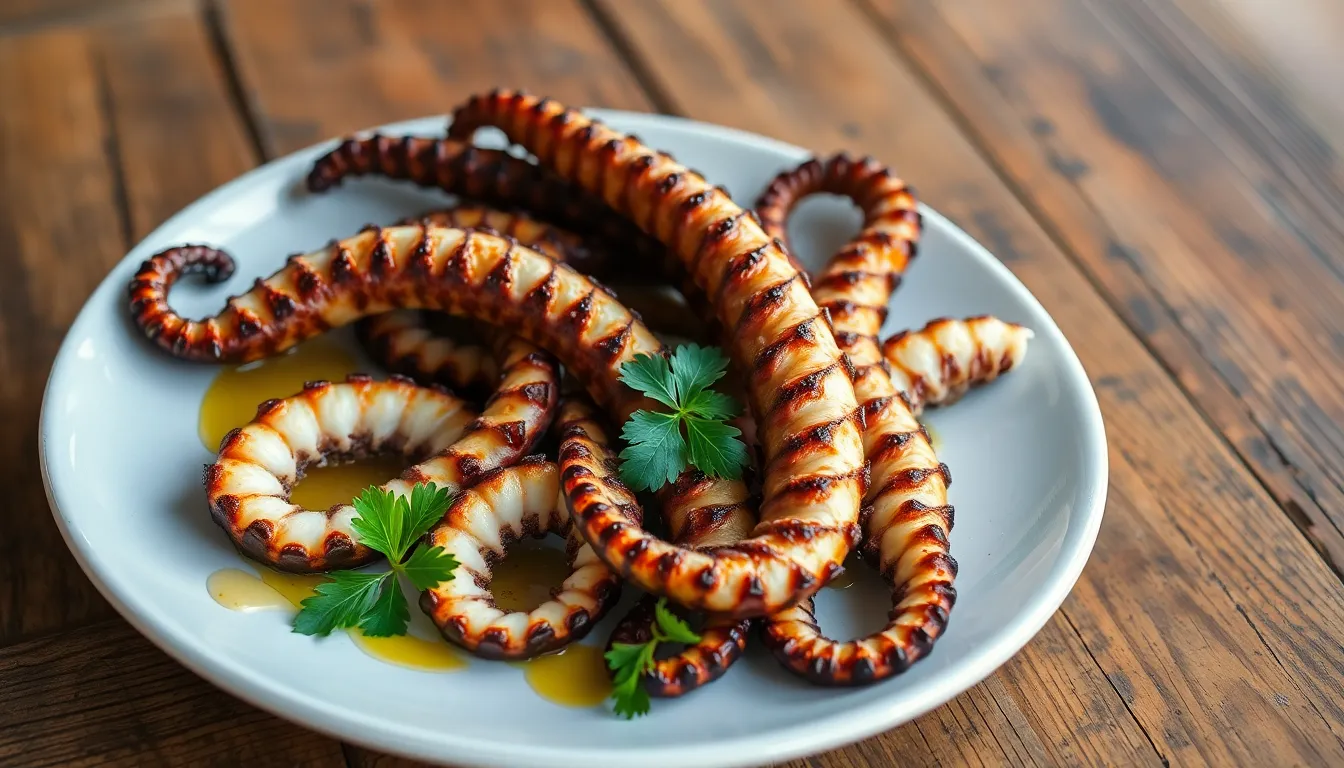
Now we transform our fresh octopus into the tender Spanish delicacy that makes coastal tavernas legendary. Follow these time-tested steps to achieve perfect results.
Prep the Octopus
We start with 2 to 4.5 pounds of fresh octopus tentacles for optimal serving size. Clean the octopus thoroughly under cold running water and remove any remaining debris. Place the octopus in our large pot and cover completely with cold water. Add a generous pinch of salt to the water before beginning the boiling process.
Tenderize the Octopus
Bring the water to a rolling boil over high heat with the octopus submerged completely. Boil the octopus until the tentacles pierce easily with a fork, typically 45 to 60 minutes depending on size. The boiling process breaks down tough fibers naturally without requiring mechanical tenderizing. Remove the octopus from the hot water and transfer to a large bowl. Cool the octopus in the refrigerator for 12 to 24 hours to allow the texture to improve and firm up properly.
Prepare the Marinade
Create our signature Spanish marinade by combining good extra virgin olive oil with coarse sea salt in a mixing bowl. Add Spanish paprika (pimentón) for authentic smoky flavor and vibrant color. Mince fresh garlic cloves and fold into the oil mixture. Chop fresh parsley and oregano leaves finely and incorporate into our marinade base. The quality of olive oil directly impacts the final taste, so we use only the finest available.
Marinate the Octopus
Remove the chilled octopus from the refrigerator and pat completely dry with paper towels. Brush the tentacles generously with our prepared marinade, ensuring every surface receives adequate coverage. Season the octopus with additional salt and paprika to taste. Allow the octopus to marinate at room temperature for 15 to 20 minutes while we prepare the grill.
Prepare the Grill
Preheat our grill to high heat, aiming for temperatures around 450°F to 500°F. Clean the grill grates thoroughly and oil them lightly to prevent sticking. We need intense heat to achieve the characteristic char that defines authentic Spanish grilled octopus. Position the grates 4 to 6 inches from the heat source for optimal cooking distance.
Grill the Octopus
Place the marinated octopus tentacles directly on the hot grill grates. Grill for 4 to 5 minutes on the first side without moving them to develop proper searing. Flip the tentacles using our grill tongs and cook for another 4 to 5 minutes on the second side. We want the exterior to turn golden brown with light charring while maintaining the tender interior texture. Avoid overcooking as this toughens the meat significantly.
Rest and Slice
Transfer the grilled octopus to our cutting board and let it rest for 3 to 5 minutes. Slice the tentacles into rounds approximately 1/2 inch thick using a sharp knife. Arrange the sliced octopus on serving plates and drizzle with additional olive oil. Garnish with fresh parsley and a sprinkle of coarse sea salt before serving immediately.
Directions for Serving
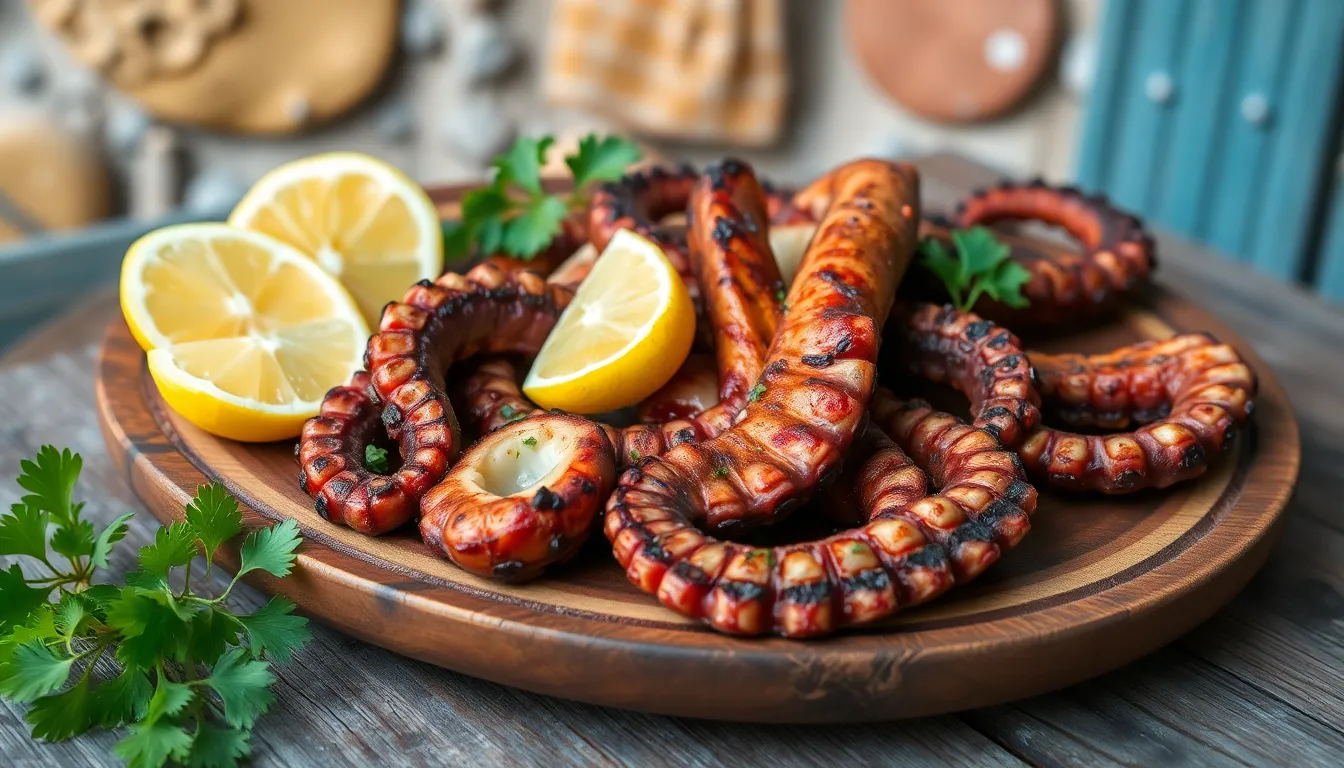
We serve our Spanish grilled octopus warm to showcase the perfect balance of tender texture and smoky char. This traditional tapa transforms into an impressive main dish when accompanied by authentic Spanish elements.
Traditional Spanish Accompaniments
We pair our grilled octopus with thinly sliced boiled potatoes dressed in olive oil and paprika, following the classic Pulpo a la Gallega tradition. The potatoes create a creamy foundation that absorbs the octopus’s flavorful juices while providing textural contrast.
Spanish smoked paprika (pimentón) adds the distinctive smoky flavor and vibrant color that defines authentic pulpo dishes. We drizzle generous amounts of high-quality Spanish olive oil over the entire dish to enhance the Mediterranean essence.
Fresh lemon wedges provide the essential acidic brightness that cuts through the rich olive oil and complements the octopus’s natural brininess. Crusty bread serves alongside to capture every drop of the precious seasoned oils.
| Traditional Accompaniment | Purpose | Serving Amount |
|---|---|---|
| Boiled potato slices | Base and texture contrast | 2-3 thin slices per serving |
| Spanish olive oil | Flavor enhancement | 2-3 tablespoons |
| Smoked paprika | Color and smoky taste | 1 teaspoon generously sprinkled |
| Lemon wedges | Acidic balance | 2 wedges per plate |
| Crusty bread | Oil absorption | 2-3 slices |
Plating and Presentation
We arrange the grilled octopus sections over a bed of warm boiled potato slices on rustic wooden plates for authentic Spanish presentation. The natural wood surface enhances the traditional aesthetic while showcasing the dish’s vibrant colors.
Our finishing touches include a generous drizzle of olive oil and fresh lemon juice applied just before serving. We sprinkle smoked paprika liberally across the entire plate, creating the signature red dusting that identifies quality Spanish octopus preparations.
Fresh parsley chopped finely provides the final garnish, adding bright green color and herbaceous notes. Simple white dishware works equally well for those preferring a cleaner presentation that highlights the octopus’s natural beauty. We position lemon wedges strategically around the plate’s edge for both visual appeal and easy access.
Make-Ahead Instructions

Planning ahead transforms this Spanish grilled octopus recipe into an effortless entertaining masterpiece. We recommend preparing the octopus 1 to 2 days before your gathering to achieve the most tender texture and deepest flavors.
Boiling and Initial Preparation (Day 1 or 2 Before Serving)
Start by boiling your octopus tentacles completely until fork tender. This crucial step typically takes 45 to 60 minutes depending on the size of your octopus. Once perfectly cooked, remove the octopus from the boiling water and allow it to cool to room temperature.
Transfer the cooled octopus to an airtight container and refrigerate for 12 to 24 hours. This resting period serves two essential purposes: it further tenderizes the meat and allows the natural flavors to concentrate and develop. The refrigerated octopus will maintain its quality for up to 48 hours when properly stored.
| Timing | Task | Storage Method |
|---|---|---|
| 12-24 hours before | Boil and cool octopus | Airtight container in refrigerator |
| 2-4 hours before | Marinate octopus | Covered bowl in refrigerator |
| 30 minutes before | Remove from fridge | Room temperature rest |
Marinating for Maximum Flavor (2 to 4 Hours Before Grilling)
Remove the octopus from refrigeration and prepare your signature Spanish marinade. Combine extra virgin olive oil, sea salt, Spanish paprika, minced garlic, fresh parsley, and oregano in a large bowl. Coat the octopus tentacles thoroughly with this aromatic mixture.
Cover the marinated octopus and return it to the refrigerator for 2 to 4 hours. This extended marinating time allows the Spanish spices to penetrate the meat while the olive oil helps maintain moisture during the grilling process.
Final Preparation Steps (30 Minutes Before Grilling)
Remove the marinated octopus from the refrigerator 30 minutes before grilling. This brief room temperature rest ensures even cooking and prevents the cold octopus from lowering your grill temperature when placed on the hot grates. Your octopus is now perfectly prepared for the final grilling step that will create that coveted charred exterior while maintaining the tender interior achieved through proper advance preparation.
Tips for Perfect Spanish Grilled Octopus
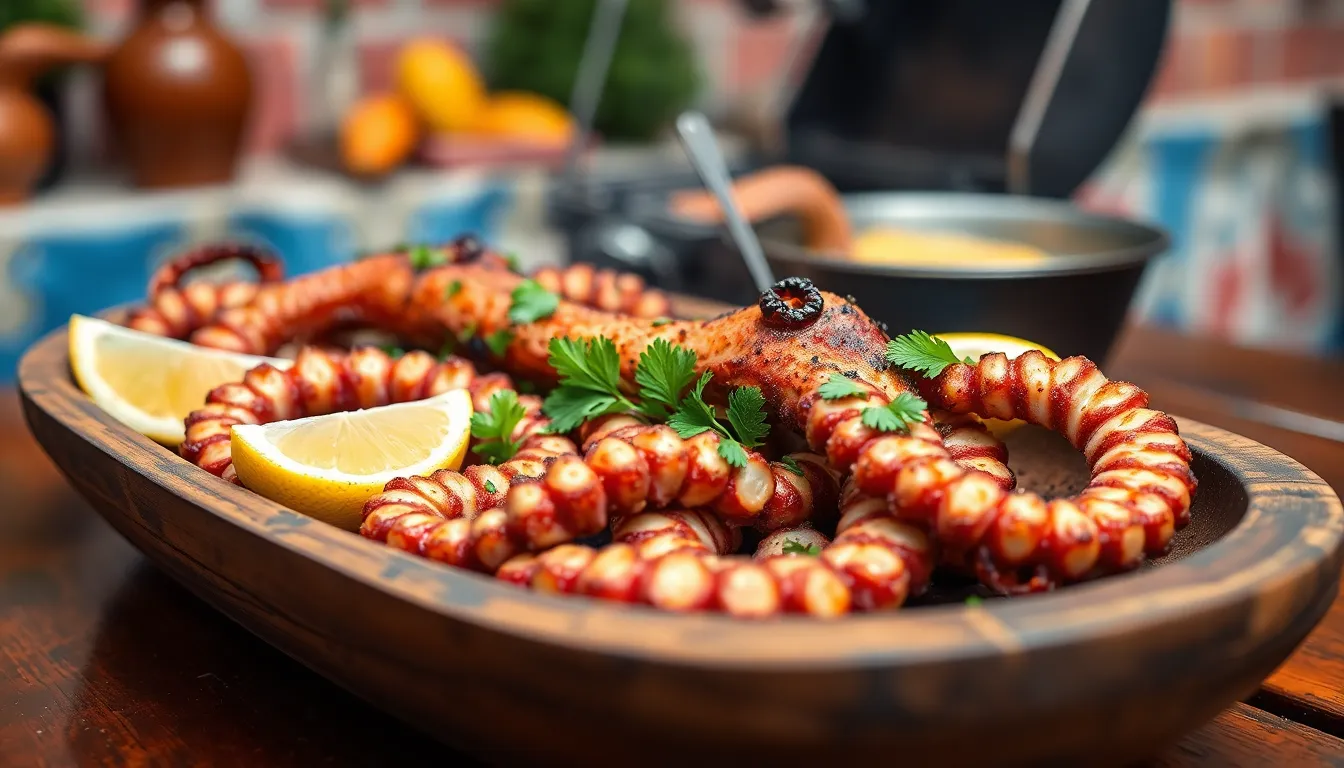
Mastering Spanish grilled octopus requires attention to three critical elements that transform this intimidating seafood into a tender delicacy. We’ve perfected these techniques through extensive testing to ensure consistent restaurant-quality results.
Selecting Fresh Octopus
Fresh octopus forms the foundation of exceptional grilled pulpo and requires careful evaluation at the market. We look for octopus that feels firm to the touch with a clean ocean-like smell that indicates peak freshness. The flesh should appear translucent with a slight purple hue while avoiding any specimens with a fishy or ammonia-like odor.
Size options include baby octopus weighing under 1 pound or larger specimens up to 2 pounds depending on your serving needs. Fresh octopus typically costs more than frozen varieties but delivers superior texture and flavor that justifies the investment. When fresh options aren’t available we recommend previously frozen octopus that has been properly thawed in the refrigerator.
Tenderizing Techniques
Proper tenderizing transforms tough octopus meat into the silky texture Spanish coastal restaurants are famous for achieving. We start by boiling the octopus in a large pot covered with enough water for approximately 40 minutes until a knife easily pierces the thickest part of the tentacle. Cooking time varies based on size with larger specimens requiring up to 90 minutes to reach proper tenderness.
The boiling process breaks down tough connective tissues that would otherwise create a chewy final product. After boiling we immediately rinse the octopus with cold water to halt the cooking process and prevent overcooking. Some traditional recipes incorporate vegetables during the boiling phase but we find plain water produces consistently tender results for home cooks.
Grilling Temperature Control
Temperature management on the grill determines whether we achieve the perfect balance of tender interior and charred exterior. We preheat our gas or charcoal grill to medium-high heat which provides enough intensity to create attractive grill marks without overcooking the already tender meat. The surface temperature should reach approximately 400-450°F for optimal searing.
Grilling time stays brief with tentacles requiring only 3-4 minutes per side to develop the desired char while maintaining internal tenderness. We avoid moving the octopus too frequently during grilling as this prevents proper caramelization and grill mark formation. High heat creates the signature slightly charred exterior that contrasts beautifully with the tender interior texture Spanish grilled octopus is celebrated for delivering.
Variations
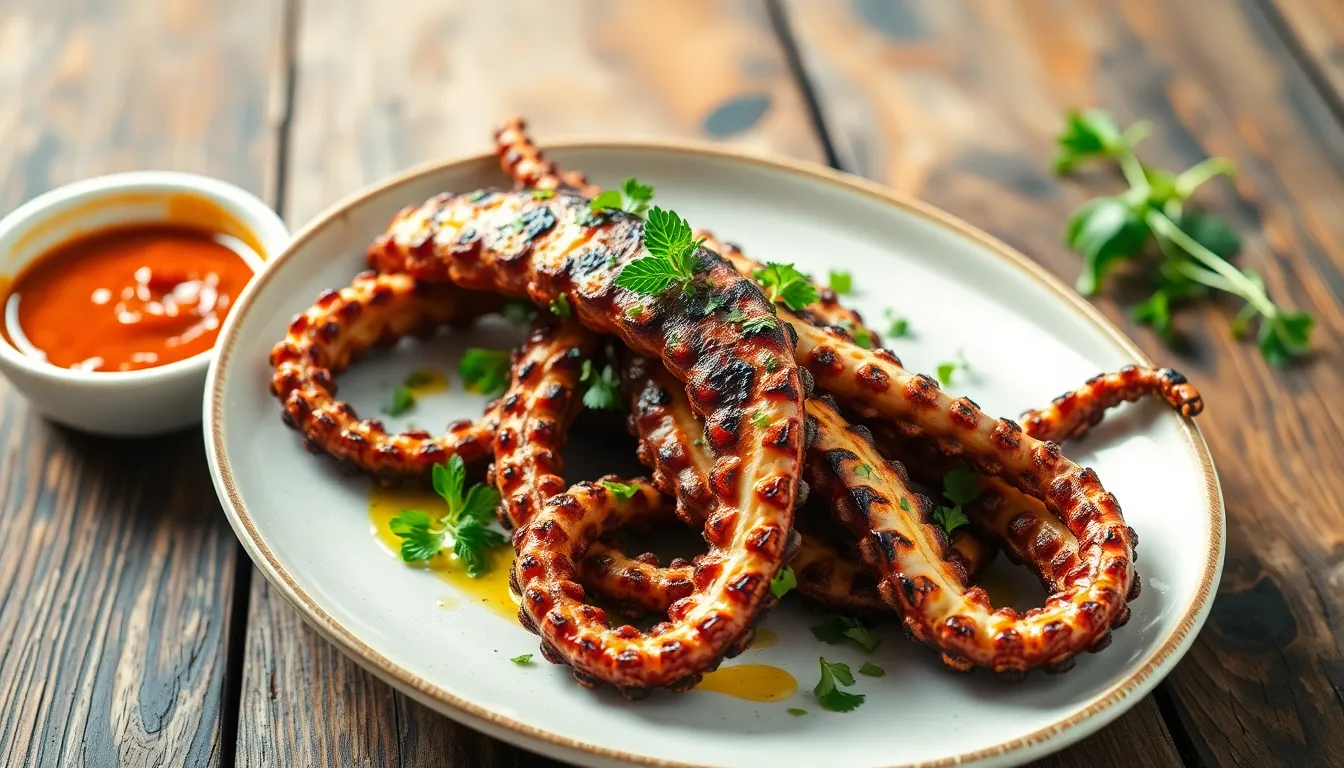
Spanish grilled octopus showcases remarkable diversity across different regions, each bringing unique preparation methods and flavor profiles. We explore these traditional variations that have evolved over centuries in coastal communities throughout Spain.
Regional Spanish Styles
Pulpo a la Gallega represents the most celebrated Galician preparation, though it focuses on boiling rather than grilling. We prepare this classic by cooking octopus until perfectly tender, then slicing it into generous rounds. The dish receives its signature presentation with coarse sea salt, premium olive oil, and Spanish paprika (pimentón) sprinkled generously over each piece. Boiled potatoes traditionally accompany this preparation, creating a hearty and satisfying meal.
Catalonian style emphasizes the grilling technique we’ve mastered, elevating the octopus with sophisticated flavor pairings. We grill the octopus until it develops beautiful char marks, then serve it alongside the region’s famous Romesco sauce. This preparation celebrates the smoky qualities that grilling imparts while adding complex nutty and earthy notes from the accompanying sauce.
Coastal towns throughout Spain often favor simple preparations that highlight the octopus’s natural flavors. We follow these time-honored methods by grilling the octopus and dressing it lightly with aromatic olive oil and fresh Mediterranean herbs. These preparations allow the seafood’s inherent sweetness and the grill’s smoky char to shine without overwhelming accompaniments.
Sauce Options
Romesco sauce stands as Catalonia’s most treasured contribution to grilled octopus preparations. We create this rich, complex sauce by blending roasted hazelnuts, red peppers, tomatoes, garlic, and olive oil into a thick, luxurious consistency. The sauce delivers earthy, nutty, and slightly smoky flavors that complement the grilled octopus perfectly, balancing its rich seafood taste with robust Mediterranean character.
Fresh herb reduction offers a lighter alternative that enhances rather than masks the octopus’s natural flavors. We prepare this sauce by combining olive oil, minced garlic, diced tomatoes, and fresh parsley with a reduction of the octopus poaching broth. This warm or room temperature sauce adds brightness and freshness while maintaining the dish’s Spanish authenticity.
Simple olive oil dressing provides the most traditional approach, allowing the grilled octopus to remain the star. We combine high-quality extra virgin olive oil with sea salt, freshly ground black pepper, and a touch of Spanish paprika. Fresh lemon juice brightens the mixture, creating a classic Mediterranean flavor profile that enhances the octopus without competing with its delicate taste.
Storage and Reheating
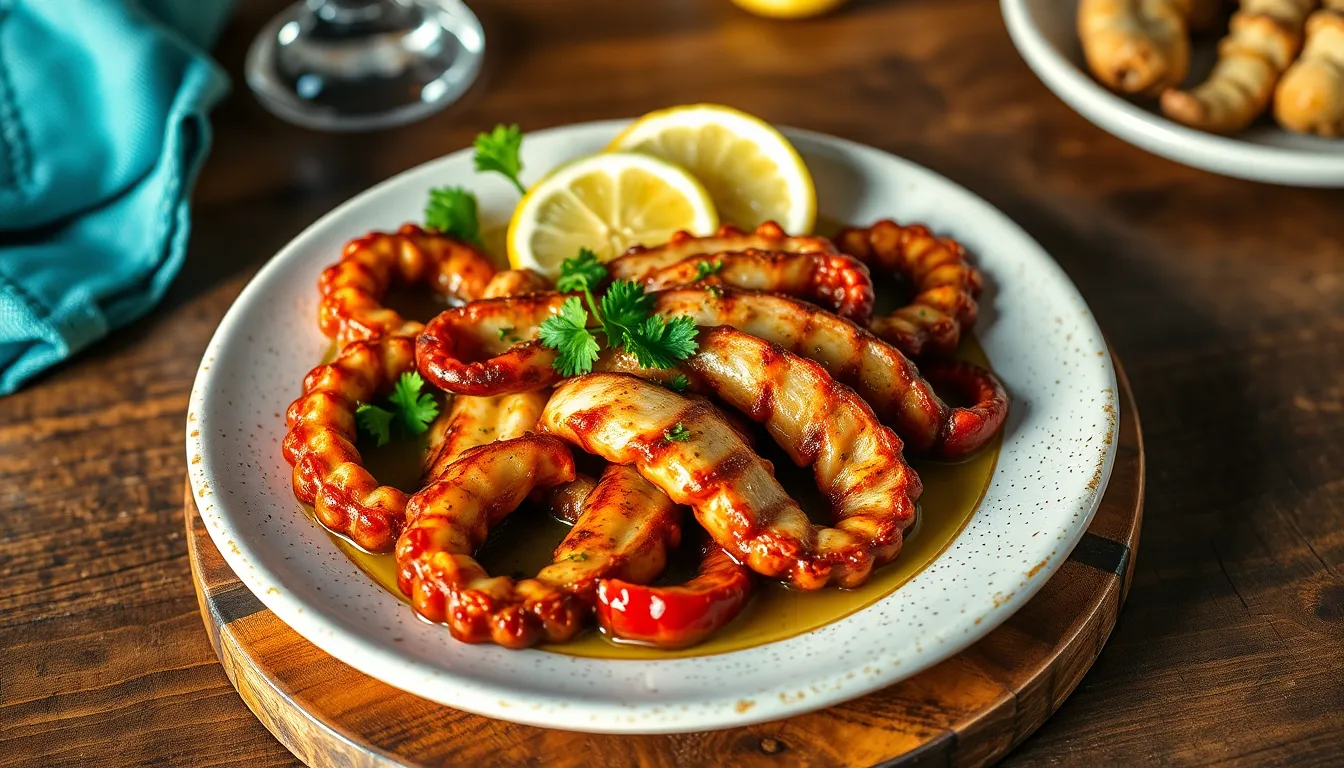
We find that leftover grilled octopus maintains its quality remarkably well when stored properly. Store your grilled octopus in an airtight container in the refrigerator for up to 2 days to preserve its tender texture and smoky flavors. Our experience shows that octopus actually develops deeper flavors after resting overnight in the refrigerator.
Reheating requires careful attention to prevent the octopus from becoming tough and rubbery. We never recommend microwaving grilled octopus as the rapid heating method transforms the tender meat into an unpleasantly chewy texture. Instead we suggest gently warming the octopus on a grill pan or skillet over medium heat until heated through.
Adding a splash of olive oil during reheating prevents the octopus from drying out while restoring its original Mediterranean flavors. Turn the pieces once during reheating to ensure even warming throughout. The process typically takes 2 to 3 minutes per side depending on the thickness of the tentacle sections.
Cold serving presents another excellent option that aligns with traditional Spanish tapas culture. We often serve leftover grilled octopus at room temperature or chilled as part of a larger tapas spread. This method preserves the octopus’s original texture while allowing the paprika and garlic flavors to shine through without additional heating.
Room temperature serving works particularly well when you want to showcase the octopus alongside fresh ingredients like boiled potatoes or crusty bread. The natural oils and seasonings maintain their integrity without the risk of overcooking that comes with reheating methods.
Conclusion
We’ve shared everything you need to master authentic Spanish grilled octopus right in your own kitchen. From selecting the freshest ingredients to perfecting those crucial grilling techniques our coastal ancestors developed over generations.
This traditional recipe transforms what many consider a challenging ingredient into an impressive centerpiece that’ll have your guests asking for seconds. The combination of proper tenderizing overnight marinating and precise temperature control ensures restaurant-quality results every time.
Whether you’re hosting a dinner party or simply craving authentic Mediterranean flavors this pulpo a la plancha recipe delivers the smoky char and tender texture that makes Spanish grilled octopus so beloved. Fire up that grill and let the magic happen.
Frequently Asked Questions
What type of octopus should I use for grilling?
Choose fresh octopus with firm flesh, a clean ocean smell, and translucent appearance. If fresh isn’t available, previously frozen octopus works well since freezing naturally breaks down tough fibers, making it more tender when cooked.
How long should I boil octopus before grilling?
Boil the octopus for 45-60 minutes depending on size, until tender when pierced with a fork. After boiling, rinse with cold water to stop cooking and refrigerate for 12-24 hours to improve texture before grilling.
What temperature should my grill be for octopus?
Preheat your grill to 400-450°F for optimal results. This high heat creates the perfect char on the exterior while keeping the interior tender. Grill for just 2-3 minutes per side to avoid overcooking.
How do I make the marinade for Spanish grilled octopus?
Combine high-quality olive oil, sea salt, Spanish smoked paprika, minced garlic, fresh parsley, and oregano. This traditional marinade enhances the octopus’s natural flavors while adding authentic Spanish taste.
What are the best side dishes for grilled octopus?
Serve with thinly sliced boiled potatoes dressed in olive oil and paprika, fresh lemon wedges, and crusty bread. These traditional Spanish accompaniments complement the octopus’s smoky flavors perfectly.
Can I prepare grilled octopus ahead of time?
Yes, prepare the octopus 1-2 days in advance for best results. Boil, cool, and marinate the octopus beforehand, then grill just before serving. This timeline allows flavors to develop and ensures maximum tenderness.
How should I store leftover grilled octopus?
Store leftovers in an airtight container in the refrigerator for up to 2 days. Reheat gently in a grill pan with olive oil, or serve at room temperature as part of a tapas spread.
What’s the difference between Galician and Catalonian octopus preparations?
Galician pulpo a la Gallega focuses on boiling with simple seasonings, while Catalonian style pairs grilled octopus with Romesco sauce. Both highlight the octopus’s natural flavors with regional Spanish touches.

